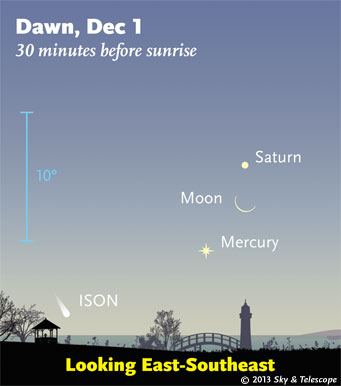
Where to try looking for Comet ISON very low in bright dawn on the morning of December 1st. Mercury, Saturn, and the Moon will be much brighter; start with them to find the spot to examine for the comet with binoculars. The comet symbol is exaggerated. Good luck.
For scale, these scenes are two or three times as wide as your fist held at arm's length.
Alan MacRobert
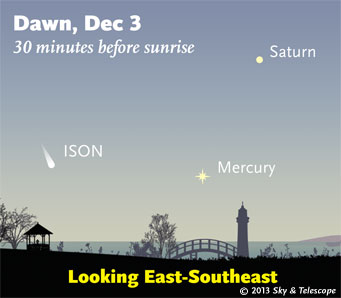
Where to try looking for Comet ISON very low in bright dawn on the morning of December 3rd. Mercury and Saturn will be much brighter; start with them to find the spot to examine for the comet with binoculars. The comet symbol is exaggerated. For scale, these scenes are two or three times as wide as your fist held at arm's length.
Alan MacRobert

Where to try looking for Comet ISON low in the dawn of December 5th. Mercury and Saturn will be much brighter; start with them to find the spot to examine for the comet with binoculars. The comet symbol is probably exaggerated. For scale, these scenes are two or three times as wide as your fist held at arm's length.
Alan MacRobert
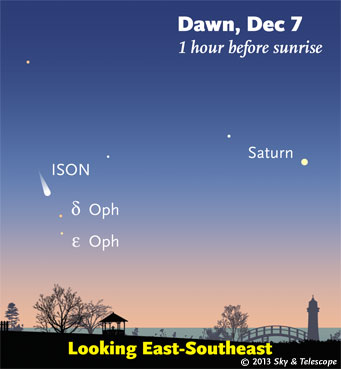
Where to try looking for Comet ISON low in the dawn of December 7th. Saturn will be brighter; start from it to find the spot to examine. The comet symbol is probably exaggerated. For scale, these scenes are two or three times as wide as your fist held at arm's length.
Alan MacRobert
This was to be Comet ISON's crucial week. The comet swung close around the Sun at perihelion last Thursday, November 28th. At first it seemed to fade and dissipate completely at perihelion, but in the hours following, a diffuse trail of debris emerged from the encounter. It briefly seemed to become brighter and more coherent before fading and dispersing further and further.
The panels here show where the remnant is located, but nothing of it can be detected though the morning twilight. See our Latest Updates on Comet ISON page.
Friday, November 29
Saturday, November 30
Sunday, December 1
All of the Red Spot's transit times this month, and all of the antics performed by Jupiter's moons, are listed in the December Sky & Telescope, pages 51 and 52.
Monday, December 2
Tuesday, December 3
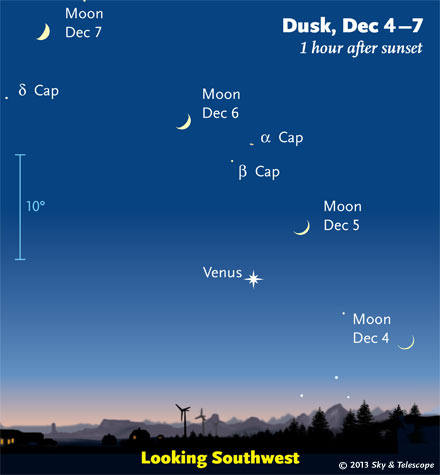
Later in the week, the Moon returns to the evening sky to pass Venus at dusk. The 10° scale is about as big as your fist held at arm's length.
Wednesday, December 4
Thursday, December 5
Friday, December 6
Saturday, December 7
The reason? Local Apparent Solar Time is shifting with respect to Local Mean Time during this part of the year, an effect caused by the tilt of Earth's axis and the ellipticity of Earth's orbit. Be glad that we use standardized time, so you don't have to keep adjusting your clocks to the inconstant motions of the Sun like in olden days. Standard time made things a lot simpler for society but complicated things for careful skywatchers.
Want to become a better astronomer? Learn your way around the constellations. They're the key to locating everything fainter and deeper to hunt with binoculars or a telescope.
This is an outdoor nature hobby. For an easy-to-use constellation guide covering the whole evening sky, use the big monthly map in the center of each issue of Sky & Telescope, the essential guide to astronomy. Or download our free Getting Started in Astronomy booklet (which only has bimonthly maps).

The Pocket Sky Atlas plots 30,796 stars to magnitude 7.6 — which may sound like a lot, but that's less than one star in an entire telescopic field of view, on average. By comparison, Sky Atlas 2000.0 plots 81,312 stars to magnitude 8.5, typically one or two stars per telescopic field. Both atlases include many hundreds of deep-sky targets — galaxies, star clusters, and nebulae — to hunt among the stars.
Sky & Telescope
Once you get a telescope, to put it to good use you'll need a detailed, large-scale sky atlas (set of charts). The standards are the little Pocket Sky Atlas, which shows stars to magnitude 7.6; the larger and deeper Sky Atlas 2000.0 (stars to magnitude 8.5); and once you know your way around, the even larger Uranometria 2000.0 (stars to magnitude 9.75). And read how to use sky charts with a telescope.
You'll also want a good deep-sky guidebook, such as Sue French's Deep-Sky Wonders collection (which includes its own charts), Sky Atlas 2000.0 Companion by Strong and Sinnott, the bigger Night Sky Observer's Guide by Kepple and Sanner, or the beloved if dated Burnham's Celestial Handbook.
Can a computerized telescope replace charts? Not for beginners, I don't think, and not on mounts and tripods that are less than top-quality mechanically (able to point with better than 0.2° repeatability, which means heavy and expensive). As Terence Dickinson and Alan Dyer say in their invaluable Backyard Astronomer's Guide, "A full appreciation of the universe cannot come without developing the skills to find things in the sky and understanding how the sky works. This knowledge comes only by spending time under the stars with star maps in hand."
This Week's Planet Roundup
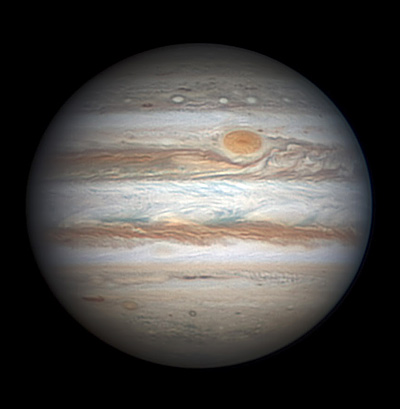
Jupiter on December 3rd, imaged about as well as it ever can be from Earth. Christopher Go used a Celestron-14 scope from his apartment balcony in Cebu City, Philippines. South here is up. Note the fine detail within the Great Red Spot, including its darker core.
Medium-aperture scopes used visually during good seeing show the Red Spot's unusually strong orange color, the turbulence on its following (celestial east) side, perhaps the white ovals south of it, the differing widths and darknesses of the big South and North Equatorial Belts, and blue festoons in the Equatorial Zone.
Mercury and Saturn (magnitudes –0.6 and +0.6, respectively) are low in the east-southeast during dawn, to the right of where Comet ISON is due to reappear very low in the first few days of December (if it survives!). The two planets start the week close together and then widen, as Mercury sinks and Saturn moves higher.
Venus (magnitude –4.9) is the brilliant "Evening Star" in the southwest during and after dusk. It's now shining at its highest and brightest for the year, and it doesn't set until about 1½ hours after dark. In a telescope, Venus has waned to a crescent 38% lit and has enlarged to about 37 arcseconds tall as it swings our way around the Sun.
Mars (magnitude 1.2, in the head of Virgo) rises around 1 a.m. By dawn it's very high in the southeast. In a telescope Mars is still tiny, 5.6 arcseconds wide.
Jupiter (magnitude –2.6, in Gemini) rises in the east-northeast around 7 or 8 p.m., with Pollux and Castor to its left. It blazes highest around 2 a.m. In a telescope Jupiter has grown to a big 45 arcseconds wide, as it nears its January 5th opposition.
Uranus (magnitude 5.7, in Pisces) and Neptune (magnitude 7.9, in Aquarius) are in the southern sky in early evening. Finder charts for Uranus and Neptune.
All descriptions that relate to your horizon — including the words up, down, right, and left — are written for the world's mid-northern latitudes. Descriptions that also depend on longitude (mainly Moon positions) are for North America.
Eastern Standard Time (EST) is Universal Time (UT, UTC, or GMT) minus 5 hours.
Like This Week's Sky at a Glance? Watch our SkyWeek TV short, also playing on PBS.
To be sure to get the current Sky at a Glance, bookmark this URL:
http://SkyandTelescope.com/observing/ataglance?1=1
If pictures fail to load, refresh the page. If they still fail to load, change the 1 at the end of the URL to any other character and try again.
 0
0
Comments
You must be logged in to post a comment.